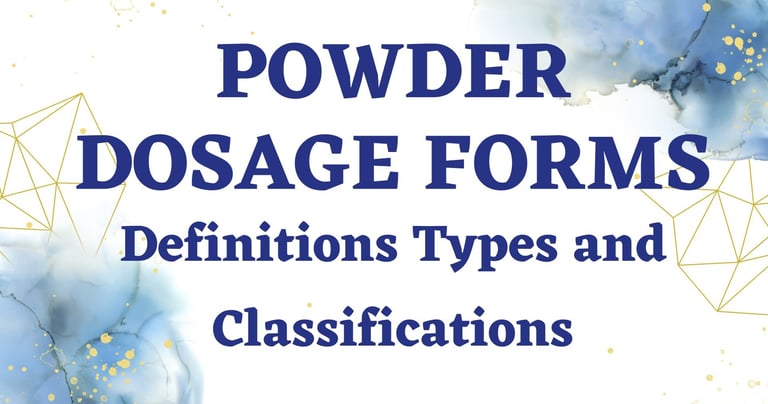Powder Dosage forms
Powder: Definition Types and Classification.
PHARMACEUTICS
Alok Bains
9/29/20232 min read


Powder Definitions: Powders are solid dosage forms containing homogeneously mixed finely divided one or more medicaments with or without excipients for internal and external use.
Types of Powders
There are two types of powders
Simple powder
Compound powder.
Classification of powders
On the basis of their applications, Powder dosage forms are classified into the following three classes
Powders for Internal Application
Divided powder
Simple powders,
Compound powders,
Cachets,
Tablet triturates.
Bulk powders
a) Antacids Powders
b) Laxative powders
Powders for External Application:
Dusting powders,
Insufflations,
Douche powders,
Dentifrices.
Special Powders:
Effervescent powders,
Eutectic mixtures.
Hygroscopic and deliquescent powders
Explosive powders
Potent powders
Granular powders
Addition of liquid in powders
Divided powder: A powder dosage form containing a single dose of medicament or medicaments with or without excipients is called divided powder.
Simple Powder: The powder containing crystalline or amorphous form of only one active ingredient with or without inert materials (excipients) is called simple powder.
Compound Powder: A powder containing a crystalline or amorphous form of two or more active ingredients with or without excipients is called compound powder.
POWDERS FOR INTERNAL APPLICATIONS
Divided Powders: A powder dosage form containing a single dose of medicament or medicaments with or without excipients is called divided powder. They are dispensed in unit dosage form wrapped in paper, cellophane, or metallic foil. Foil and cellophane wrapping is a better choice to protect the powder from the external atmosphere.
Cachets: Catchets are solid unit dosage forms that contain powder medicament with or without excipients enclosed in wafer sheets or catchets. Catchets are prepared from a mixture of rice flour and water. Molds are used to give proper shape to cachets. Cachets are used to administer nauseating and unpleasant taste drugs. But, there will be little protection for drugs from light and moisture. Nowadays, they are not in use and are replaced by capsules. There are two types of cachets:
Wet cachets: There are two parts of cachets; the lower half and the upper half. The drug is filled in the lower half of the cachet. The upper half of the cachet is moistened with water and pressed over the lower of the cachet.
Dry cachets: There are two parts of cachets; the lower half and the upper half. The drug is filled in the lower half of the cachet. The upper half is pressed over the lower half of the cachet without using moisture.
Tablet triturates: One or more medicaments with or without excipients molded into a tablet are called tablet triturates. This dosage form is not in use in allopaths.
Bulk Powders: A powder dosage form containing homogeneously mixed multiple doses of one or more medicaments with or without excipients inside one container is called bulk powder.
